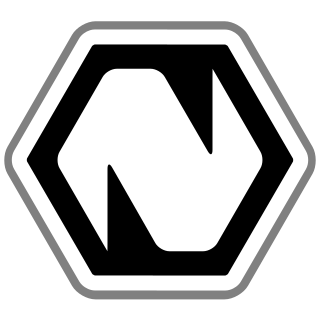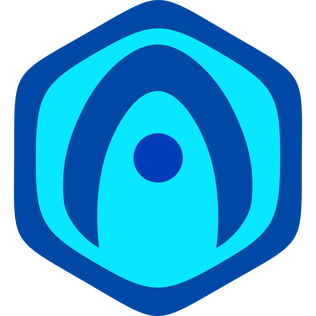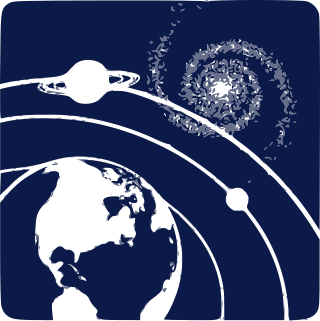
Blender is a free and open-source 3D computer graphics software tool set used for creating animated films, visual effects, art, 3D-printed models, motion graphics, interactive 3D applications, virtual reality, and, formerly, video games. Blender's features include 3D modelling, UV mapping, texturing, digital drawing, raster graphics editing, rigging and skinning, fluid and smoke simulation, particle simulation, soft body simulation, sculpting, animation, match moving, rendering, motion graphics, video editing, and compositing.
X3D is a set of royalty-free ISO/IEC standards for declaratively representing 3D computer graphics. X3D includes multiple graphics file formats, programming-language API definitions, and run-time specifications for both delivery and integration of interactive network-capable 3D data. X3D version 4.0 has been approved by Web3D Consortium, and is under final review by ISO/IEC as a revised International Standard (IS).

jMonkeyEngine is an open-source and cross-platform game engine for developing 3D games written in Java. It uses shader technology extensively and can be used to write games for Windows, Linux, macOS, Raspberry Pi, Android, and iOS. It uses Lightweight Java Game Library as its default renderer and another renderer based on Java OpenGLand also supports OpenGL 2 to OpenGL 4.

OpenSceneGraph is an open-source 3D graphics application programming interface, used by application developers in fields such as visual simulation, computer games, virtual reality, scientific visualization and modeling.
The canvas element is part of HTML5 and allows for dynamic, scriptable rendering of 2D shapes and bitmap images. It is a low level, procedural model that updates a bitmap. HTML5 Canvas also helps in making 2D games.
Web3D, also called 3D Web, is a group of technologies to display and navigate websites using 3D computer graphics.

WebGL is a JavaScript API for rendering interactive 2D and 3D graphics within any compatible web browser without the use of plug-ins. WebGL is fully integrated with other web standards, allowing GPU-accelerated usage of physics, image processing, and effects in the HTML canvas. WebGL elements can be mixed with other HTML elements and composited with other parts of the page or page background.

Away3D is an open-source platform for developing interactive 3D graphics for video games and applications, in Adobe Flash or HTML5. The platform consists of a 3D world editor, a 3D graphics engine, a 3D physics engine and a compressed 3D model file format (AWD).
CopperLicht is an open-source JavaScript library for creating games and interactive 3D applications using WebGL, developed by Ambiera. The aim of the library is to provide an API for making it easier developing 3D content for the web. It is supposed to be used together with its commercial 3D world editor CopperCube, but it can also be used without.

Sketchfab is a 3D modeling platform website to publish, share, discover, buy and sell 3D, VR and AR content. It provides a viewer based on the WebGL and WebXR technologies that allows users to display 3D models on the web, to be viewed on any mobile browser, desktop browser or Virtual Reality headset.

Flare3D is a framework for developing interactive three-dimensional (3D) graphics within Adobe Flash Player, Adobe Substance and Adobe AIR, written in ActionScript 3. Flare3D includes a 3D object editor and a 3D graphics engine for rendering 3D graphics. Flare3D runs on current web browsers utilizing the Adobe Flash Player, and uses Stage3D for GPU-accelerated rendering. Flare3D has not been under active development since late 2014.

PlayCanvas is an open-source 3D game engine/interactive 3D application engine alongside a proprietary cloud-hosted creation platform that allows for simultaneous editing from multiple computers via a browser-based interface. It runs in modern browsers that support WebGL, including Mozilla Firefox and Google Chrome. The engine is capable of rigid-body physics simulation, handling three-dimensional audio and 3D animations.

JanusVR is a corporation based in San Mateo, California, and Toronto, Ontario, that develops immersive web browsing software. It was founded by James McCrae and Karan Singh in December 2014. Named after Janus, the Roman God of passages, JanusVR portrays web content in multi-dimensional spaces interconnected by portals.

Natron is a free and open-source node-based compositing application. It has been influenced by digital compositing software such as Avid Media Illusion, Apple Shake, Blackmagic Fusion, Autodesk Flame and Nuke, from which its user interface and many of its concepts are derived.
Experience Curiosity is an interactive web application developed by NASA's Jet Propulsion Laboratory to celebrate the third anniversary of the Curiosity rover landing on Mars. This 3D serious game makes it possible to operate the rover, control its cameras and the robotic arm and reproduces some of the prominent events of the Mars Science Laboratory mission. The application was presented at the beginning of the WebGL section at SIGGRAPH 2015.

glTF is a standard file format for three-dimensional scenes and models. A glTF file uses one of two possible file extensions: .gltf (JSON/ASCII) or .glb (binary). Both .gltf and .glb files may reference external binary and texture resources. Alternatively, both formats may be self-contained by directly embedding binary data buffers. An open standard developed and maintained by the Khronos Group, it supports 3D model geometry, appearance, scene graph hierarchy, and animation. It is intended to be a streamlined, interoperable format for the delivery of 3D assets, while minimizing file size and runtime processing by apps. As such, its creators have described it as the "JPEG of 3D."

Babylon.js is a real time 3D engine using a JavaScript library for displaying 3D graphics in a web browser via HTML5. The source code is available on GitHub and distributed under the Apache License 2.0.

Verge3D is a real-time renderer and a toolkit used for creating interactive 3D experiences running on websites.
Facebook 3D Posts was a feature on the social networking website Facebook. It was first enabled on October 11, 2017 by introducing a new native 3D media type in Facebook News Feed. Initially the users could only post 3D objects from Oculus Medium and marker drawings from Spaces directly to Facebook as fully interactive 3D objects. The feature was available for desktops and mobile phones that support the underlying WebGL API.

NASA's Eyes Visualization is a freely available suite of computer visualization applications created by the Visualization Technology Applications and Development Team at NASA's Jet Propulsion Laboratory (JPL) to render scientifically accurate views of the planets studied by JPL missions and the spacecraft used in that study. The Eyes family of products is available for desktop computers running Windows 7+, and Mac OSX 10.8+. Deep Space Network Now and Experience Curiosity are web-based and available across all platforms. 3D models of spacecraft and other objects are displayed with the option of comparing their size to a human, school bus, or football stadium.











